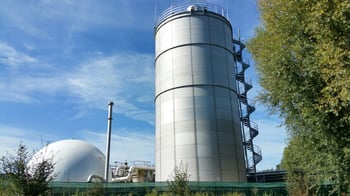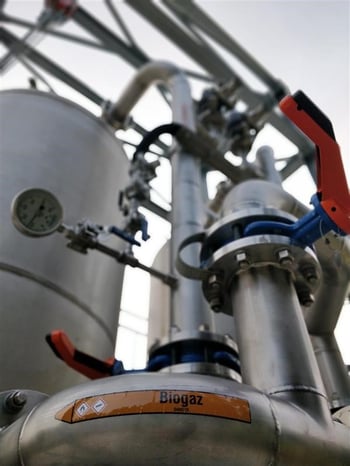As one of a number of methods for treating the liquid organic effluents produced by industrial processes, methanization significantly reduces carbon-rich pollution, at the same time as producing smaller quantities of residual sludge and delivering energy efficiency. It can even be used to recover a proportion of effluents by producing biogas!
2 ways of reducing the energy bill of an industrial plant

It seems like methanization is already a very mature technology in the world of agriculture, but it has also been a reality on industrial sites for the past two decades. This process is part of what we refer to as industrial decarbonization, and is particularly relevant to sectors that produce carbon-rich effluents, which include the food industry and papermaking, for example. The fact is that methanization achieves very high levels of efficiency in treating the organic load of this particular type of industrial effluent.
But what exactly is it? An anaerobic biological process. In this process, bacteria are used to break down organic matter in a reactor requiring no oxygen supply, which is the first financial advantage of this technology, and also the first step towards reducing industrial plant energy bills.
Better still, it requires the use of a reactor with a generally smaller footprint, which is fairly easy to install and operate. Especially since it can be adapted to meet the specific needs and demands of industrial users. This is particularly true for the methanization technology based on granular sludge, which is the industrial effluent treatment solution adopted by Saur Group Industrial Water Solutions company Econvert. The liquid effluent flows through granular sludge that remains in permanent suspension. At the top of the reactor, a three-phase separation stage separates the granular sludge from the treated effluent and the resulting biogas. This then is the second way of reducing the energy bill of an industrial plant, because the biogas can be used to fuel a boiler or be sold to the national gas supply operator for injection into the grid.
Methanization, or how to save money without compromising efficiency

Building a conventional effluent treatment system for organic-rich wastewater is a much more expensive option, not only financially, but also in terms of time, because casting huge concrete tanks and waiting for the concrete to dry can be very time consuming. Running a conventional plant also has significant costs, from aerating the concrete tanks to managing the residual sludge they produce.
Methanization is one of the most efficient biodegradable effluent treatment processes available.
“It can eliminate 80% of carbon-rich pollution”
And therefore produces relatively little in terms of residual sludge. This in itself can solve some of the thorny problems involved in managing industrial plant waste. Especially since the residual sludge from the methanization process can also be recovered for reuse in another reactor.
Methanization can therefore be seen as a liquid industrial effluent pretreatment technology that is highly effective in reducing its organic load before secondary processing in a more conventional activated sludge treatment phase. It also limits the footprint of the entire process, and reduces energy costs, at the same time as complying fully with regulatory discharge standards.
To find out more and take the next step, download our illustrated guide to methanization!
![[Illustrated guide] Using methanization to treat your effluents and generate energy - A guide](https://no-cache.hubspot.com/cta/default/7160320/edf1079b-0646-43e2-a7e7-18d056620526.png)